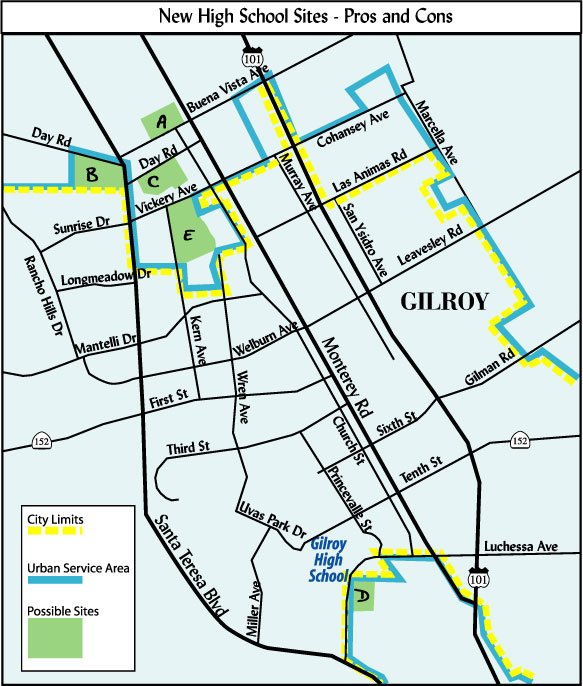GILROY
– Not many people involved with constructing a school for
ultimately 1,800 students would expect an effort of this scope to
be pain free.
It takes time, it takes money, it takes resolve to work through
the likely environmental and community impacts a large scale
project brings.
GILROY – Not many people involved with constructing a school for ultimately 1,800 students would expect an effort of this scope to be pain free.
It takes time, it takes money, it takes resolve to work through the likely environmental and community impacts a large scale project brings.
But in recent days, the drive to build Gilroy Unified School District’s second comprehensive high school has been stymied by more than development issues. Politics and personality have entered – and blurred – the picture, too.
GUSD officials wanted the planning process to be a methodical and efficient game plan ending in 2008 when the new high school would open. Instead, it has become a political football, pitting trustees against the mayor and calling into question the preferred school site of each party.
On June 19, trustees will likely accept a committee recommendation to make a 50-acre parcel on Day Road the site for a new high school. That decision would come four days before a joint meeting between the city and the school district – a session Mayor Tom Springer was hoping would kick off a second phase of the site selection process.
Mayor’s preferred site
Specifically, the mayor wants to use city staff to help determine which of the school district’s five favorite sites is best suited for the 40- to 50-acre campus. And, he believes he has the answer – acreage on Vickery Avenue between Wren and Kern avenues.
“No one has sat down and put all the sites on a piece of paper and asked the experts to put down a list of pros and cons,” Springer said. “Why not put all the data (regarding community impacts and development costs) into a matrix and study it ahead of time with land-use planning experts before making a selection. What’s wrong with having technical people construct a technical matrix?”
The mayor’s belief is frustrating to Rogers and Kraemer who describe the high school site selection as a two-year process that involved public and private meetings with the mayor as well as meetings between school district and city staff.
But clouding the cooperative effort is the mayor’s belief that the school district found, and began pushing for, the Day Road site after most of those meetings occurred.
“The district just sort of plopped the Silveira Property (the name of the family that owns the Day Road site) onto the list. The first I heard of it was from reading the newspaper,” Springer said.
The district feels Springer plopped an idea on them, too. Before a special board meeting last week, Springer told Day Road residents and members of the media about a “sixth option” – Southpoint Business Park – that should have been added to GUSD’s list of five preferred sites. GUSD headquarters is in the east Gilroy industrial park and would neighbor a high schoolif one is built there.
The mayor later clarified that the suggestion was done cynically to point out the district’s zealous approach to find a one-lot, one-owner parcel. At least some in attendance took the mayor’s idea seriously.
“The school district members seemed to be overriding the location consideration with the guiding principle of a one-owner, one-large-parcel basis. Then cynically speaking, why not consider the Southpoint site because it even better meets those so-called requirements,” Springer wrote in an e-mail to The Dispatch.
Conspiracy theories
The rift between trustees and the mayor has put the motives of both sides under more scrutiny.
Although no one is openly espousing conspiracy theories, questions are being asked about why the mayor is lobbying hard for the Wren/Kern site.
Santa Clara-based developer Wren Investors, also known as Dividend Homes, owns a more than 18-acre parcel of land on Vickery Avenue between Kern and Wren avenues. Wren Investors lost its bid for the right to build homes there in the last round of Gilroy’s housing allocation, raising the question of whether the company is working with the mayor behind the scenes to sell the land some other way.
Skip Spiering, a land acquisitioner for Wren Investors, would not comment on whether his firm approached district or city officials, or vice versa. The mayor, however, admits he approached Wren Investors and other developers and land owners in the area after the school district invited the public in May to bring forth alternate ideas for a high school site.
Similarly, questions are emerging over the school district’s interest in the Day Road site. Glen-Loma Group, a high-profile land owner and developer in Gilroy, is working with the Silveira family to develop the 60-acre Day Road site into a 10-acre Catholic church and school and a 50-acre housing development for more than 200 homes.
Like Wren Investors, Glen-Loma Group also lost its bid for housing allocations.
Glen-Loma owns other parcels around town that have been mentioned in discussions with GUSD as potential sites for future schools. So, it could only benefit GUSD to keep Glen-Loma happy.
For instance, when it comes time to build a new elementary school to replace the aging Las Animas site, GUSD could save money by swapping the Las Animas land with a parcel Glen-Loma owns on the south end of town. GUSD has already approached the city to allocate housing rights to the Las Animas site. Doing so would increase the potential value to a developer interested in acquiring the Las Animas site.
“Frankly, it just so happens that Glen-Loma is the land broker for the Silveiras. They don’t own the land,” Rogers said. “The district has to go with what they think is the best site. I’m comfortable with (Glen-Loma being involved).”
Location location location
For Springer, putting a new high school at what he describes as the “extreme” edge of the city (Day Road), goes against the district’s original intention of a north-central location. He says children living in many existing homes around town would have to walk or drive a long way, significantly impacting traffic and requiring extensive and costly road improvements.
The Day Road residents opposed to the new high school have stressed similar traffic concerns to the school board.
District officials argue that any site will have road and traffic issues to contend with. They also claim to be thinking long term.
“Right now, the best geographic location might look like Wren and Kern,” Kraemer said. “But in 20 years there will be more houses north and Day Road will be the more north-central site.”
The LAFCO effect
GUSD hasclearly stated its wish to avoid hassles with the anti-sprawl Local Agency Formation Commission. LAFCO has the power to deny city services – such as police and fire protection, water and sewer, roads and utilities – to development it does not authorize, including schools.
Only one of the district’s preferred properties – the Day Road site – is in the so-called Urban Service Area. USA designation means, essentially, that a city’s services can be delivered to the area because plans are to incorporate that area into city boundaries in roughly five to 10 years.
“LAFCO is being turned into the boogieman so the Day Road site can be pushed through,” says Springer.
Springer points to the example of Sobrato High School in Morgan Hill which is currently being developed. Like the Wren-Kern alternative, the Sobrato site exists immediately outside of city limits.
“Using the Sobrato precedent, LAFCO should give the Wren-Kern site its blessing,” Springer said.
Happy neighbors
It’s standing with LAFCO is not the only advantage GUSD sees in purchasing the Day Road site. The school district also likes that the Silveiras are the only owners of the parcel, and they are willing sellers.
At Wren and Kern, 20 of the 50 acres are owned by unwilling sellers. A survey of some of the parcel owners revealed that at least three owners – making up roughly eight acres – are not ready to sell their land.
“We’ve been here 24 years. We wanted to subdivide this property eventually and build homes for our kids. I don’t know if we could find the same sort of land for the same price,” said Wendy Spohr, a Kern Avenue resident with one acre.
GUSD is hesitant to use its power of eminent domain – the right to take land for a fair price if it benefits the public good.
“You can be left with, instead of good neighbors, bad feelings,” Assistant Superintendent Lee White told trustees last week.
Springer wants to see the land owners brought into a public discussion because some of them may be ready to sell their property in 10 years. GUSD plans to build the high school in two phases, first for 900 students and later for a capacity of 1,800. Springer says the school could start the project on the 30 acres owned by willing sellers.
If in the future, the other land owners were still unwilling to sell, Springer says the district could offer them a land swap using its property at Kern Avenue that currently houses the GHS farm.
“I’m speculating on the possibilities, but this is exactly why the school district should be having public discussions,” Springer said. “They’ve had some discussion, but it’s far too little.”
Time and money
GUSD’s goal is to complete the first phase of the high school by 2008, when an enrollment 3,000 is projected for GHS. Gilroy High School was constructed for less than 2,000 students and is already over-capacity.
GUSD officials have held no secrets about wanting to purchase a site that gives the aggressive timeline the best chance to work.
About $39 million from a recently passed school bond has been set aside to purchase land and construct a new high school. Roughly one-fourth of that sum is likely needed for the land purchase.
Local Realtor Chris Ordaz has been researching potential properties for the district. He believes the value of the Day Road land and the Wren-Kern lots could be different by $100,000 an acre or more.
“We don’t have formal figures, but the land at Day Road is definitely going to come in cheaper,” Ordaz said.
But Springer has an answer for the money concern, too. The city and the school district often work together to build parks, pools and gyms on campuses. Typically, the city funds the construction and the district operates the facility. In the school day, students have use of the facility. At night and on weekends use is turned over to the general public.
Springer says if, for instance, a regional park is built at Wren and Kern, the city would likely pick up the cost of expensive roadwork, saving GUSD at least hundreds of thousands of dollars.
“This is another example of an option that hasn’t been fully researched,” Springer said.














